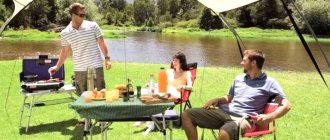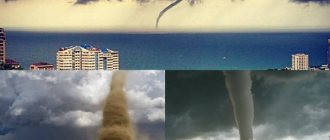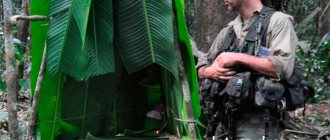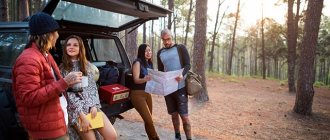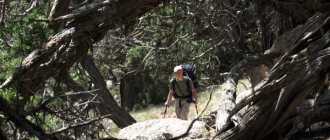Terms
The article discusses the rules for organizing comfortable sleep in tents at low temperatures and high humidity. The physical condition of a person on a hike is largely determined by the quality of sleep and its duration. Sleep quality is characterized by the number of times you wake up within 8 hours due to discomfort.
There are two types of sleep organization: “cold” and “warm” (the smaller brothers call the second type “hot tenting”). In accordance with the standard DIN EN ISO 23537 (formerly EN 13537), a winter sleeping system is considered comfortable if a man weighing 75 kg (woman 60 kg) of average build and metabolism, dressed in seasonal thermal underwear, lying on a bed (mat) ) with a total thermal stability coefficient “R - value” equal to 8 units, sleeps soundly for 8 hours. 8 units, has a “sandwich” of a foam mat 10 mm thick (2 units) and a self-inflating mat 50 mm (5.5 - 6 units).
“Warm” means sleeping in a specialized mobile shelter (stove tent or tent) with an autonomous, low-maintenance heating device.
Currently, wood stoves, gas and liquid heaters are used as camp heating devices. The fuel used is firewood, pressed sawdust briquettes, liquefied petroleum gas (not to be confused with compressed gas), fuel oil, diesel fuel, kerosene, refined gasoline and food grade alcohol, which is controversial for use by compatriots as a fuel.
Special stove tents and tents are distinguished by a special shape, the presence of a special ventilation system, a special composition of tent materials (antipyrite treatment, fire-resistant screens) and cuts for the chimney.
What you need to take with you on summer camping:
| 1 | First aid kit. Sometimes people forget about safety rules while on vacation and get injured. For this reason, we recommend that you be sure to have bandages, adhesive tape, disinfectants and painkillers with you. It would also be a good idea to grab something to normalize the functioning of the gastrointestinal tract and against poisoning. |
| 2 | Sunscreen, glasses and hats are essential items when staying at the beach for a long time! |
| 3 | A properly selected tent for the current temperature, weather, location, length of stay, number of people and other factors. How to choose the right tent and other equipment, you can read this link or ask us... |
| 4 | Air or self-inflating mattress. Good rest is simply not possible without deep, sound and comfortable sleep. — We do not recommend taking foam mats! Due to their low weight, they are popular for hiking and camping, where every gram counts, but in a car camping environment, you can choose something much more comfortable! — And of course, we do not recommend going to bed without any mattresses or rugs. This is not only inconvenient, but also dangerous to your health! The surface cools down greatly in the morning and you risk hypothermia... For tents below 120 cm, we recommend taking self-inflating mats; if the tent is higher, then take an inflatable mattress and ensure maximum comfort on your vacation... |
| 5 | Summer sleeping bags. Firstly, it is softness and comfort. Not everyone knows that a sleeping bag is not just a warm “cocoon”. It can be unzipped, after which it becomes something like a blanket in form and function. Lay one such blanket on a double mattress for softness and thermal insulation, and cover yourself with the second. We guarantee you sleep stronger and sweeter than at home! Well, secondly: despite the summer heat, it can be very cold in the mornings and you can easily ruin your vacation by catching a cold on the first night. |
| 6 | Take more drinking water! We recommend taking at least 4 liters per adult per day. If you plan to drink strong alcohol, you will need even more water... |
| 7 | Flashlights and lamps. With the arrival of darkness they will become essential items. There should be plenty of them! |
| 8 | Skewers or “grid”? If you plan to fry meat over a fire, we recommend taking skewers rather than a mesh grill. And it’s not about culinary preferences at all! Indeed, if the wind increases, the skewers can be washed from grease and used as long, reinforced pegs to secure a tent or awning. |
| 9 | Warm clothes. In the evenings, near the sea it can be cool and the opportunity to warm yourself will not be superfluous. |
| 10 | Gas stove. Even if the purpose of the trip is to fry meat over a fire, we recommend taking a stove and a couple of gas cylinders. In the summer heat, it’s still a “pleasure” to light a fire “from scratch” in the morning for a cup of coffee or to heat up breakfast. |
| 11 | Camping furniture. If eating “off the floor” is not usual for you or you are planning “get-togethers”, we recommend that you take care of the furniture. Although tables and chairs will take up some space in the trunk of a car, they will provide you with a comfortable rest. |
| 12 | Earplugs and blindfold. If dawn is not part of your plans and you are not accustomed to sleeping with extraneous sounds and light, then thanks to them you will be able to sleep for another hour or two when the sun rises in the morning and the “fuss” begins around you. |
| 13 | A spatula is usually not needed in 95% of cases. But when you really need it, in 95% of cases you don’t have it with you and you desperately regret not taking it. =) So let it be better! |
| 14 | Shade from the sun. Any even two-layer tent allows a significant portion of UV rays to pass through. Therefore, if you are going to a place without shelter and plan to stay under the open sun at noon, we recommend taking a thick sun awning with you, under which you will be able to comfortably wait out the heat. |
| 15 | Think about entertainment. Starting with active ones (beach and water), ending with books and board games, which will come in handy when you are hiding in the shade from the midday sun. |
A few words about insulated (three-layer, quilted) tents
Many people think that quilted tents with geofelt are the warmest.
We have a quilted, expensive one, integrated with a snowmobile sled. This tent works well as long as moisture from gas, precipitation and breathing does not freeze inside the insulation. In these tents, the dew point is always inside the insulation. When the moisture freezes, when it thaws or the heater's power is added, it begins to drip onto the top of the head, and a frozen tent cannot be folded into a sled. I will quote the answer of one of the most respected manufacturers of four-season tents, with which I completely agree:
“We tested different designs. Tents with two separate awnings turned out to be much warmer than quilted ones with insulation, but we also produce the latter due to strong demand, including from government agencies.”
Translation:
Quilted tents are convenient for weekend trips, work well in dry weather conditions, are usually used as one-day tents, and the fight against popular myths contradicts the goals of extracting added value.
More detailed translation:
They sell horsepower and pixels, not torque and optics. Manufacturers usually do not write that almost everything is decided by timing and optics because the consumer buys horsepower and pixels. A buyer without serious experience in winter expeditions does not see the air between the awnings, which is the best insulation, but he sees geofelt, similar to the cozy quilted jacket he is familiar with. Therefore, a quilted tent made of geofelt 5-10 mm thick will always have its buyer, despite the fact that two tents are warmer.
The quilted tent in the photo above measuring 190 x 220 x 185 cm usually requires a heater with a power of 4 kilowatts, and the two-awning tent in the photo below with a diameter of 270 cm and a height of 185 cm in similar conditions requires 2 kilowatts. And nothing can be done about these facts, the laws of physics.
Hundreds of days of personal testing have confirmed that two - canvas stove tents with waterproof inner awnings are the warmest. In addition, they do not get wet, frost and drops do not fall off them. Single-layer ones turned out to be the coldest, and quilted ones were the most demanding in terms of humidity and the power level of the heating device. If the power of the heating device was insufficient, ice would freeze inside the insulation, which is quite natural if you think about where the dew point should be in a tent with insulation and how to move it to the external awning.
For poppy
For the most effective use of geofelt and any other fiber insulation, it must be insulated from steam from inside the tent, precipitation, dry quickly and easily, and not be sealed between layers of waterproof fabric (otherwise it will become a breeding ground for mold).
From personal experience, the warmest tent turned out to be a hybrid, in which two waterproof awnings are covered with a third waterproof one with insulation in the form of thin geofelt glued onto it. Moreover, the role of the geofelt itself as insulation seems insignificant compared to the functionality of the third awning made of thick oxford with a skirt. This insulation rather works as a spacer (air gap) between the second and third awnings. The photo shows the Bereg tent “UP-2” with warm floors, an arctic cape, and a long-burning wood stove “Economka Srednyaya”.
Such three-awning tents (not to be confused with the marketing “three-layer”) tents actually ensure operation in any weather conditions, from heavy rain to (-60 C).
Clothes for spending the night in winter
It is not advisable to spend the night in a tent in winter wearing trousers. Stock up on wool pants and socks (this is an important condition in your case) for an overnight stay. They say that simple pants go well with warmer clothes. To spend the night, it would be a good idea to have a sweater that is hot to wear during the day. You can wear a flannelette shirt under a sweater. We recommend protecting your chest and throat, so take care of yourself and pay attention to your clothing.
Be sure to wear clean and dry underwear. I’ll say right away that wet laundry is a great way to get dry quickly and efficiently. That is why the first thing you should always do when climbing into a tent is to put on dry clothes.
It will not be superfluous to put on a hat at night; your head can get terribly cold at night, and then you will have to treat it. I think you don’t want to wake up with a headache or freeze from the cold.
Wearing more clothes in a tent in winter in the forest is definitely not unnecessary. Let you feel a little hot, not too much. The coldest is always felt in the morning and at dawn, when the body's mobilized forces run out. Your heat loss should be minimal while you sleep. Why should you get up from your own trembling - take care of yourself in the evening, otherwise you will regret it.
All these tips, without heating in a tent, are suitable down to -20 degrees, and even then not for everyone.
Well, the last thing I wanted to note is that you won’t be cold at all when you wake up in the morning, if you use tents with a stove, minimize the unpleasant sensations from the frost. The large umbrella tent UP 5 is suitable for large companies for 5-6 people; in this form, the severe cold can be endured with ease.
This is interesting: How to build a bunker with your own hands
Protection from draft and wind
Draft (not to be confused with ventilation) and wind, along with water, are the worst enemies of a warm sleep. The ventilation of a winter tent should always be open, in any frost. A draft due to open ventilation occurs only in tents of stupid designs. Even very expensive companies have such copies. For example, when spending the night in the open air, the temperature of the comfort limit of a sleeping bag at (-37 °C) with a wind of less than 1 meter per second was (-5 °C).
In order for the air insulation layer to work effectively, it should not be blown out by a draft; increased air migration between the awnings is also unacceptable. This means that a tent whose outer awning does not reach the ground closely, as well as single-layer ones, are not four-season, no matter what the manufacturers write in the annotations. Completely windproof tents have a wide skirt that lies flat on the ground, and the ventilation windows are located above people's heads, but below the thermal wedge - a layer of very hot air at the top of the tent. The absence of drafts, the presence of a thermal wedge and developed ventilation above the heads are very important. If the inner awning of the tent is also windproof, then the likelihood of a draft at bed level is zero.
Single-layer tents are fundamentally unable to completely eliminate drafts, cold air migration and provide thermal insulation at the level of a two-layer tent. For the same reason, stove tents with a breathable (blown) inner awning are colder than stove tents with a windproof (waterproof) inner awning.
Bed
Proper thermal insulation from the ground is one of the axioms of a good winter sleep.
The ideal 8 winter R - value units are obtained on a “sandwich” of 10 mm foam and 50 mm self-inflating carpets; they can be reduced to 6 units, but even they are equal to 30 mm of polyethylene foam. In addition, under no circumstances should there be any gaps under the sleeping body that would allow cold air to migrate from the ground to the sleeping bag.
None of the currently existing inflatable and self-inflating carpets completely blocks the migration of cold air from the ground to the sleeping bag. Therefore, sleeping on a single 50mm thick self-inflating mat is significantly cooler than sleeping on a sandwich of 10mm foam and 38mm self-inflating. In addition, there are no indestructible self-inflators, and being left without a carpet in winter is the last thing, worse only without shoes and a jacket. Therefore, one foam mat should be available in any case.
The simplest winter bed, guaranteed to ensure no sensations of cold during 8 hours of sleep, is a homemade carpet made from two sheets of building polyethylene foam insulation measuring 1000 x 600 x 40 mm each,
glued into a single piece with a technical adhesive on both sides to ensure that there is no gap in the middle of the body, which is very important. 30mm will also work satisfactorily.
